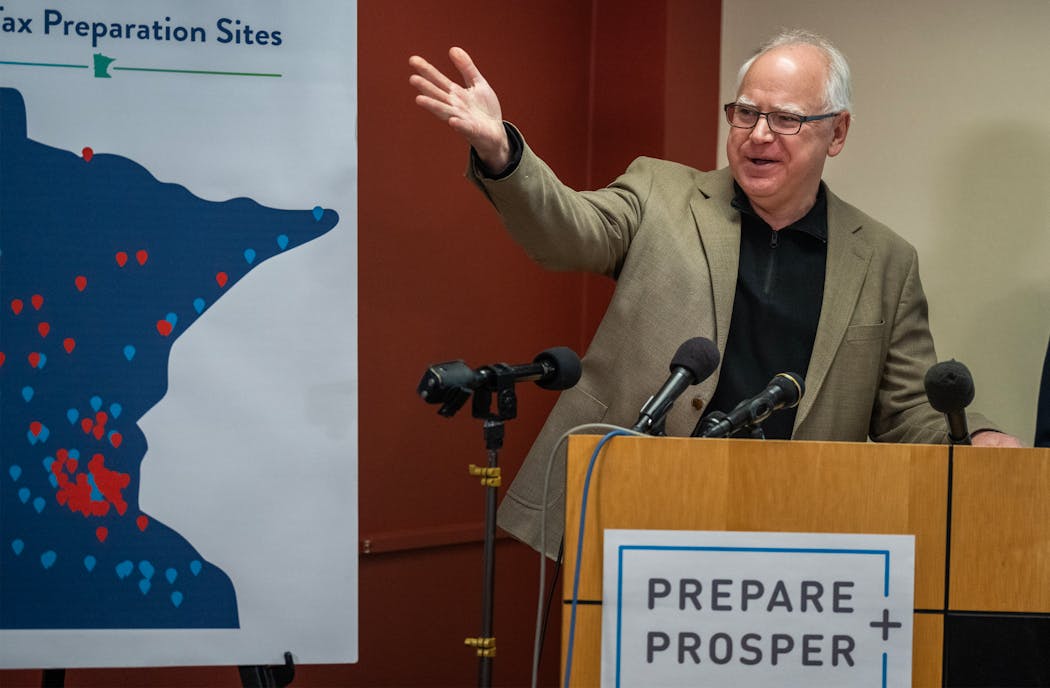Nearly 300,000 Minnesota families can receive up to $1,750 per child in new tax credits this year — the highest child tax credit in the country.
On Monday, Gov. Tim Walz joined state leaders to boost awareness about the tax credit, which DFLers tout could cut poverty in Minnesota by a third by helping families financially.
"That's how we get to reducing childhood poverty in Minnesota by a third," Walz said. "If this works right, by the end of the year, Minnesota should have the lowest childhood poverty rates in the entire country."
The Legislature approved the permanent child tax credit last year, and it will cost the state an estimated $400 million a year.
To receive the tax credit, families have to file a 2023 income tax return. The $1,750 credit is for each child 17 years old and younger, with no limit on the number of children.
The credit phases out for Minnesotans whose income is more than $29,500, or $35,000 for married joint filers, but the credit doesn't taper out completely until about $95,000 in income for a family with four kids. Minnesota Department of Revenue Commissioner Paul Marquart said he encourages taxpayers to see if they qualify for the credit through tax forms at revenue.state.mn.us/child-tax-credit.
"This is real money that's going to provide stability for families," Lt. Gov. Peggy Flanagan added. "It's a win, win, win in the short-term for families and in the long-term for the state of Minnesota."
The tax credit will be adjusted for inflation each year. Even Minnesota residents who aren't legally required to file taxes — including taxpayers under the age of 65 who made less than $13,825 in income in 2023 or under $27,650 for married joint filers can receive the child tax credit if they file a tax return.
In just one week in January, 48,000 taxpayers claimed the child tax credit — a quarter of tax filers that week — and received an average of $1,253 in tax credits. State officials are spreading the word about the new tax credit using some lessons learned in the COVID-19 pandemic, including tapping trusted community organizations to share information directly.
Walz said the extra help will buoy families' finances, which will help the state's economy.
"This money is going to families; it's going to buy shoes in your local store. It's going to buy tires in your local tire store," Walz said.
During the pandemic, the federal child tax credit was expanded to help families but that extra aid ended in 2021. Just this month, the House passed a bipartisan bill that includes raising the child tax credit, but it still needs Senate approval.
How to get free tax prep
Many families who qualify for Minnesota's state child tax credit also qualify for free tax preparation at 170 sites statewide, such as Prepare & Prosper, a nonprofit in St. Paul. Residents who are over the age of 60 or families with an annual income of about $60,000 or less qualify for free tax preparation. To find a free tax prep site, go to revenue.state.mn.us/free-tax-preparation-sites.
Donna Zochert, 74, and her husband, Mark Mohaupt, 68, of Richfield have turned to Prepare & Prosper for help filing their taxes the last four years. With Mohaupt retired and Zochert working part time as a business owner of a barber shop, she said filing their taxes can be complex.
"The idea I can come and do this and not pay exorbitant amounts [to do my taxes], it's wonderful," Zochert said.
Walz greeted the couple on Monday as he toured Prepare & Prosper's offices on Monday. "We'd be lost without it," Mohaupt told Walz.
Prepare + Prosper volunteer Mark Nolen helps residents navigate the process and find what tax credits and rebates they qualify for. When he told one client she qualified for the state's new tax credit, she was shocked.
"She's just like, 'Huh, what just happened here?'" Nolen said. "It's going to change lives."
Brooklyn Park police make arrest after asking for help in search for man suspected of sexual assault at gunpoint

Attorney Tayler Rahm wins GOP backing in battleground Second District
North Oaks withdraws request for density exemption from Met Council



